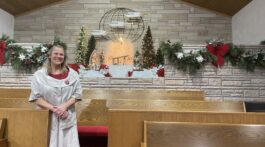Sabbath School Lesson for May 23-29, 2020
Overview
Comparing the Genesis account to pagan myths, we find these areas to be of interest:
- How and where did the idea of a flat earth become popular? (Sunday)
- How was the Creation of man seen in ancient pagan literature? (Monday)
- How was Creation completed in Genesis, compared to Near Eastern accounts? (Tuesday)
- What is distinctive about the genealogies provided in the book of Genesis? (Wednesday)
- How did New Testament writers view the Genesis account of Creation? (Thursday)
Introduction
Many of the most memorable early scientists, like Kepler and Isaac Newton, were inspired to study science and nature by what they found in the Scriptures. They believed that their findings added to our knowledge of God’s handiwork.
It wasn’t until Charles Darwin’s book On the Origin of Species (1859) that philosophical ideas began to change significantly from a theistic, God-centered worldview to one based on naturalism and materialism.
Modern science has since grown farther and farther from the biblical foundation presented in the book of Genesis, usually leaving no place for the supernatural workings of a Creator.
Memory Text: “The heavens declare the glory of God; and the firmament shows His handiwork.” Psalm 19:1 NKJV
Does the Bible teach a culturally outdated view of the universe, or can the follower of God still believe in the Genesis account of Creation as a logical explanation of our origins?
As the psalmist proclaims, we can be informed by the study of the world around us, including the vast stars and planets that inhabit the cosmos. God’s glory and creative power are evident, when we take the time to listen and observe our natural surroundings. This should be the goal of every scientist–to listen and observe the workings of God.
Sunday: A Flat Earth?
There’s been a false impression that the Bible taught that the earth was flat, and, of course, science has solidly proven it to be circular. In fact, most Bible scholars of the Middle Ages did falsely assume that the Bible taught the earth was flat.
But these Bible scholars incorrectly interpreted some references in Revelation to reach that incorrect conclusion. When read in context, the verses that talk about the “four corners of earth” are merely speaking figuratively about the four directions: north, south, east, and west. In other words, something that comes from all around us.
There were other Bible prophets who did understand the circular shape of the earth, however. In Job 26:7, for instance, it says, “He stretches out the north over empty space; He hangs the earth on nothing.” This sounds much like the earth being suspended in space, as science certainly has found to be true. In verse 10, it even talks about a circular horizon, which is also a confirmation in the roundness of our earth. Isaiah 40:22 also mentions God, sitting above the circle of the earth.
Although it’s true that most people at one time believed the earth was flat, it is not true that the Bible teaches that it is flat.
Bible Verses to Ponder and Share:
Job 26:7-10
- Why is it important to study the natural world around us? What can we learn about God, as Job seems to have done, despite his many calamities and trials?
Isaiah 40:21, 22
- What is meant by the “circle of the earth”? How would Isaiah know about the roundness of our planet?
Revelation 7:1 and 20:7, 8
- What is a more logical way to interpret these verses than to see them teaching that the earth is flat? How does this emphasize the need to correctly interpret Scripture?
Monday: Creation in Ancient Literature
Archaeology has made many discoveries of ancient literature over the years, and, in most cases, has found ways to translate their findings.
Not surprisingly, much of the content they uncover deals with our most basic philosophical questions. Such as where do we come from, what is our purpose in life, and where are we going in the future.
Most of the literature from ancient times fall far short when it comes to answering these basic questions of our existence. Even though there are similarities in the way they depict things like the creation of our planet and the great flood that covered the earth, they do not adequately satisfy our longing for truth about God.
Only the ancient biblical account provides us with an omnipotent God, who has given mankind a dignified purpose for being here. We can be thankful for the Bible’s accurate depiction of ancient events, and know that it is far superior to pagan stories that have always circulated around the world in one form or another.
The Bible alone has survived the test of time and continues to provide humanity with hope and purpose on a large scale.
Bible Verses to Ponder and Share:
Genesis 1:27, 28
- How do we see God providing men and women with a dignified position in the world, so unlike ancient, pagan myths that try to explain man’s existence?
Tuesday: Genesis Versus Paganism
Moses’ upbringing in Pharoah’s court, and his later years of shepherding in Midian among the surrounding pagan tribes, gave him a clear picture of the harm of Satan’s idolatrous forms of worship.
Seeing the prevalent worship of the sun and moon may have even influenced Moses to omit naming them in the Creation account. He cautiously refers to them as “the greater light” and “the lesser light”.
As important and beautiful as all the things God created are, we should never allow ourselves to worship the created, in place of the Creator. Nature should point us in the direction of God in heaven. That’s why Moses intentionally made God the central focus of his record of the Creation.
The pagans literally chose things that God created, making them into graven images to worship. But Satan is just as successful today in getting us to showcase the created, instead of the Creator. We can so easily become fanatics about the environment, either protecting it or destroying it–or even about our bodies, something else God created–once again, destroying our health or overly protecting it.
Bible Verses to Ponder and Share:
Genesis 1:14-19
- For what specific purposes were the stars, sun, and moon given in the Creation account?
- How had pagan religions altered the purpose of the stars, sun, and moon?
- Why does Satan strive to get us to focus on the creation more than the Creator?
Genesis 2:7, 18-24
- What special care did God give in the creation of man and woman?
- Why weren’t they spoken into existence, like the rest of the things God created?
- How do pagan myths differ from the story in Genesis?
Wednesday: Creation and Time
How helpful it is to have the genealogies in Genesis 5 (from Adam to Noah) and chapter 11 (from Shem, Noah’s son, to Abram). Not only are names given, but how long they lived. This linking of time and family members helps us feel a strong lineage all the way back to God, who created us.
These chronogenealogies, as they might be called, have also allowed Bible scholars to determine the age of the earth, and the time of the Flood. There have been attempts in recent years to discredit these genealogies by accounting longer time periods for the generations, but there is no firm evidence of the need to do this.
1 Chronicles 1:18-27 repeats and corroborates the list of descendants in Genesis, giving no added names or missing generations. God has provided us with this helpful tool, helping us see our connection with Adam and all of mankind, and even our precious connection with God, who made Adam.
Bible Verses to Ponder and Share:
1 Timothy 1:4
- How does Paul see the tendency to credit pagan myths as truth, as opposed to faithfully accepting God’s word, as it is written?
Titus 3:9
- Is it genealogies themselves, or the disputes over them, that Paul is worried about in this text? For what reason are genealogies helpful, when accepted as they are given in Scripture?
Thursday: Creation in Scripture
All through the New Testament, references are made to events that date back to the time of Genesis–the Creation, the Flood, Abel, Cain, Enoch, even the tree of life. Yes, all these are mentioned in almost every book of the New Testament. It is so frequently done that we must assume these references to be reliable, historical accounts worthy of our attention.
Even the genealogies found in the Bible, linking Adam’s descendants all the way to Jesus, the Promised Seed, are important for us to be able to see the fulfillment of the plan of salvation.
Jesus’ life and death on Calvary’s cross are certainly prefigured in almost all the Old Testament Scriptures. For example, Paul explains in Romans 5:12, 14-19 how Adam was a type (or prefigured symbol) of Christ. Whereas by one man (Adam) sin and death entered the world, by one man also (Jesus Christ) sin and death would someday be no more.
We can think of many other examples of Bible characters who pointed forward to some attribute or event that hints at the unfolding story of our redemption. Even Jonah’s spending three days in the belly of a whale reminds us of how long Jesus was in the tomb. (Friday, Sabbath, and Sunday would be three days, in the Hebrew reckoning of time.)
Bible Verses to Ponder and Share:
Luke 11:51, 52
- Why would Abel be considered God’s first martyr?
- Why were so many of God’s prophets asked to shed their blood?
Romans 1:20
- How does this verse validate the Creation story, as told in Genesis?
- What “invisible attributes” of God are seen through nature?
Romans 5:14, 17
- In what way was Adam a “type”, or prefigurement, of Jesus? What do they have in common?
Friday: What We Have Learned This Week
Satan is doing all he can to divert our attention and worship away from the Creator of heaven and earth. Modern science, which has mostly discarded the notion of a supernatural god, is just the newest version of pagan teachings that have been with us since Adam and Eve first sinned.
Pagan religious systems, which essentially includes any religion outside Christianity, tend to focus on the created and miss the true connection we have with God. They typically enforce strict codes of conduct that must be met, in order to secure the favor of the gods they believe are behind their demands.
Thus, these false religions are based on righteousness by works. They teach that we must earn the blessings the true God has freely offered to those who follow Him. Even Cain, who chose to offer a sacrifice based on his own labor, was listening to Satan’s enticing words to please himself, not God. We must not fall into the same trap.
Instead, let’s vow to keep our eyes fastened on the unchangeable, omnipotent, all-knowing Creator found in the book of Genesis. Anything else leads to our eventual destruction.
Next Week’s Lesson: The Bible as History
To read the Sabbath School Lesson Quarterly or see more resources for its study, go to
https://www.absg.adventist.org/
Other Outlook blogposts by Teresa Thompson, are at http://outlookmag.org/author/teresathompson/
Also, Teresa is livestreaming daily about the lesson on her Facebook page










